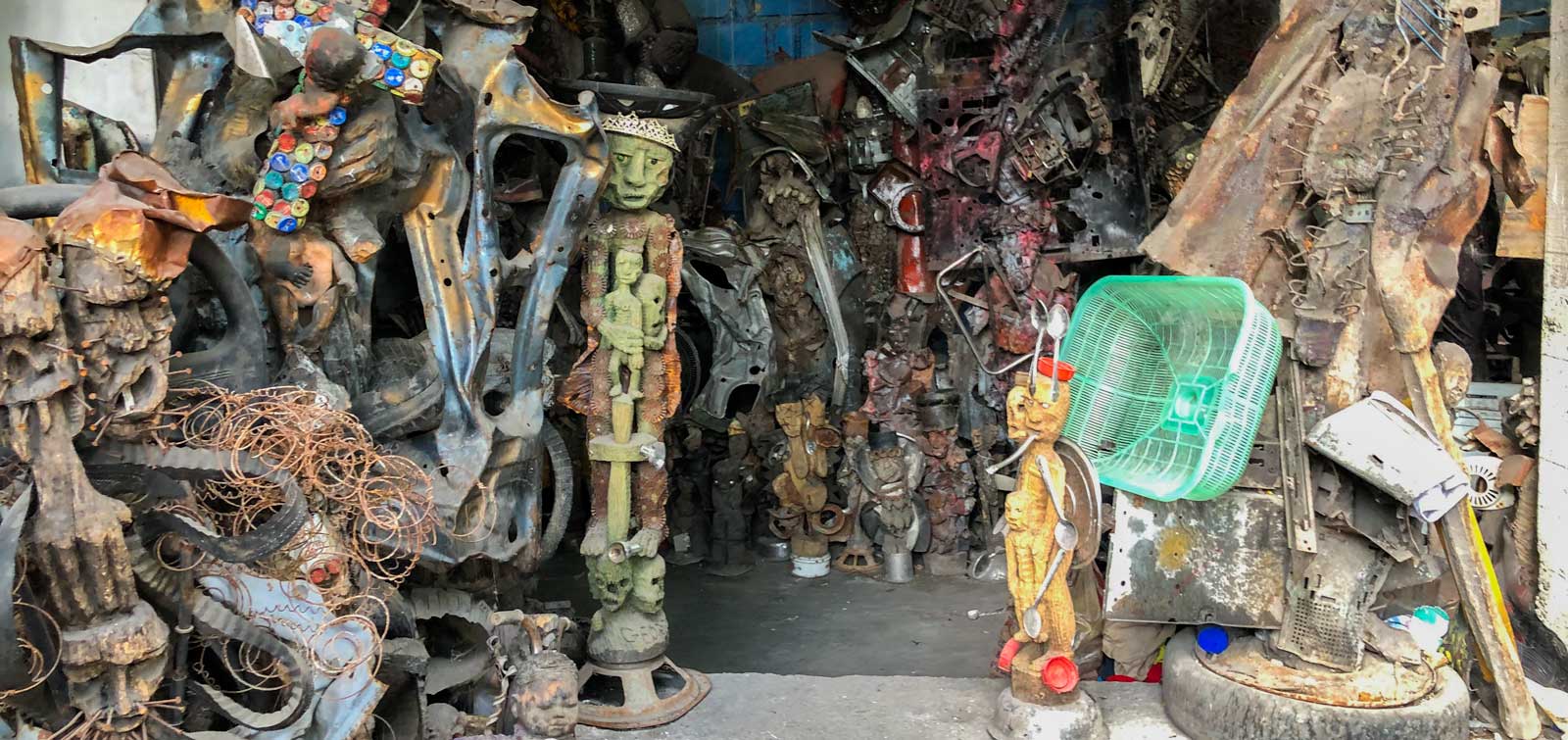
Photo: Anton Lau
Meet the Cyberpunk Artists of Grand Rue
The Atis Rezistans
Atis Rezistans, Creole for “artist resistance”, is a Haitian collective that upcycles debris into Vodou-infused cyberpunk sculpture. At the epicenter of the Rezistans in downtown Port-au-Prince in Grand Rue is the studio of André Eugène: a workshop, gallery and museum well worth a visit.
To reach Andre Eugene’s studio, drive down the main causeway on Grand Rue until you reach an enormous black metal arch with “Atis Rezistans” etched in black letters. These arches are two-storey-high metalwork structures made in the Rezistans signature style, using foraged scrap metal to create a distinctly post-apocalyptic atmosphere, with hints of the mystical. This is the headquarters of Atis Rezistance.
Getting to Grand Rue
Driving through downtown Port-au-Prince to the dusty, vendor-lined streets of Rue Jean-Jaques Dessalines, you see glimpses of the past era of austere grandeur that once characterized the area’s wide boulevards.
Locally known as Grand Rue, this avenue cuts a north-south passage through the capital from Bel Air and La Saline all the way to La Cimetiere and Carrefour. At the southern end, Grand Rue’s once imposing multi-story buildings recall an era of successful business and thriving tourism, but the informed traveller knows that main attraction these days isn’t on the main street, but behind it.
In the labyrinthine back streets off the main avenue, surrounded on all sides by the city’s informal car repair district, you’ll find the home of the creative community that makes much of the souvenirs sold around Haiti and right across the Caribbean island. It’s no coincidence these now-famous workshops are surrounded by junkyards: this is where the Atis Rezisans find the materials for their art.
Today in Grand Rue, colonial grandeur has long since been supplanted by grit and the organic chaos of haphazard urban architecture. Makeshift homes with cement walls and blue tarpaulin doors form a maze punctuated by broken-down Mac trucks and cars with their guts exposed. Every free square meter is occupied by welders and informal vendors seated on gravity-defying chairs propped up with more luck than legs. The Haitian spirit of degage or ”make do” is alive and well here on Grand Rue.
This strange place is home to Atis Rezistans,”Resistance Artists” a collective of Haitian sculptors and artists whose home studios you can now visit. These inventors are renowned for their ability to transform junkyard debris into mixed-media sculpture, creating figures replete with sexual, spiritual and humorous symbolism that laughs in the face of bourgeois gallery standards.
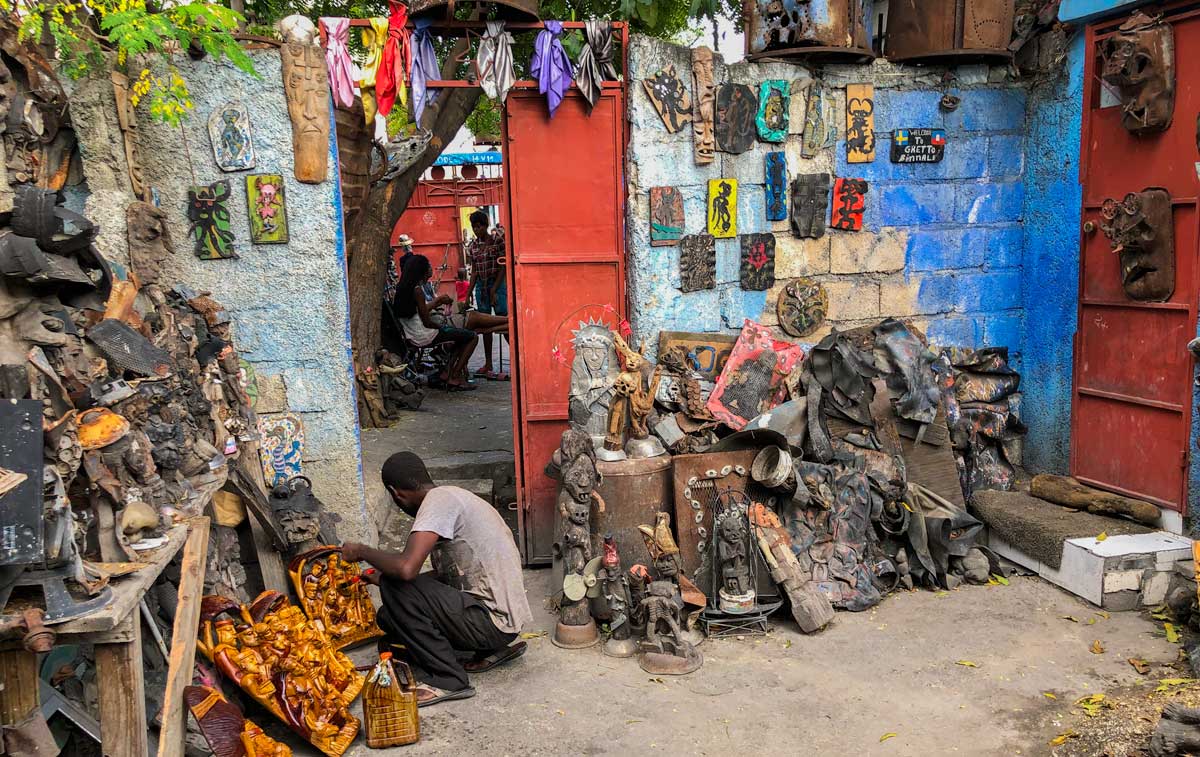
Photo: Anton Lau
Enter the world of Atis Rezistans
In the first studio, extreme cyber-punk meets upcycling with a Vodou overtone. To the left and right, the edges of the workshop sporadically light up with the bright arcs of welding torches. Navigating your way through these several mini galleries leading to Eugene’s studio is a baptism into a creative alternate reality. The artists themselves are easily found, and you can buy pieces of sculpture directly from their creators here in the workshop-studios.
Twenty yards into the maze-like corridors, you reach Eugene Andre’s studio. Here your eyes take in a sculpture garden like no other in the world. Imagine an empty five car parking garage covered in a staggering array of other-worldly creatures – artefacts twisted, turned and upcycled from parts pulled from wreckage. It’s diabolical and heavenly.
On any given day, you can find Eugene here, kneeling with his welding torch in hand, surrounded by a wall of twisted metal behind him and a sea of possible parts to his left. He’s a heavy-set man in his late fifties with boundless energy, and a penchant for wearing blue overalls with nothing underneath. The sweet floral scent of sacred ceremonial water and incense infuse the air with a temple-like feel, contrasting sharply with the futuristic scrapyard vision over which he presides.
On one white wall, rubber tires have been stretched and carved into 2D figures, hanging by the dozen. The rubber sculptures appear alongside their metal brethren like an army of dark rebel spirits descending into the bright Caribbean light. Rusted carburetors and doll arms – raw materials from the nearby car repair shops and junkyards – are strewn on the ground next to completed sculptures. The studio is so packed with art and ingredients that only Eugene knows his way through. If you ask, most of the sculptures and artefacts are for sale.
Several walls on the ground floor of the open-air space are adorned with sequined Vodou flags. Each intrinsically beaded piece of satin represents the cosmograms of various gods and goddesses or “lwa” in Haitian Vodou. The snake windinging down a tree is for Damballa, and the mermaid spirit “La sirene” are easily spotted. Most of these are for sale too, and much easier to take home if you don’t have too much room left in your luggage. But this is just the ground level of Eugene’s three-storey temple to creativity.
The sparsely decorated second level feels more like a classic art gallery. Windowless concrete walls are painted stark white. A series of impressive, waist high metal sculptures are neatly planted throughout a series of rooms. It’s an attempt at the orderly, but the bent towards chaos below reaches up from below in the sounds of ‘ting ting’ hammering, soldering, welding and angle-grinding.
The cacophony falls away as you climb to the third and final level of Eugene’s studio. This new addition is an open-air rooftop space. It serves as an exhibition area for fellow neighborhood artists – members of the Atis Rezistans. It’s also a classroom and meeting space. If you’re here at the right moment, it’s a brilliant place to watch the sun set over downtown Port-au-Prince with a cold Prestige in hand.
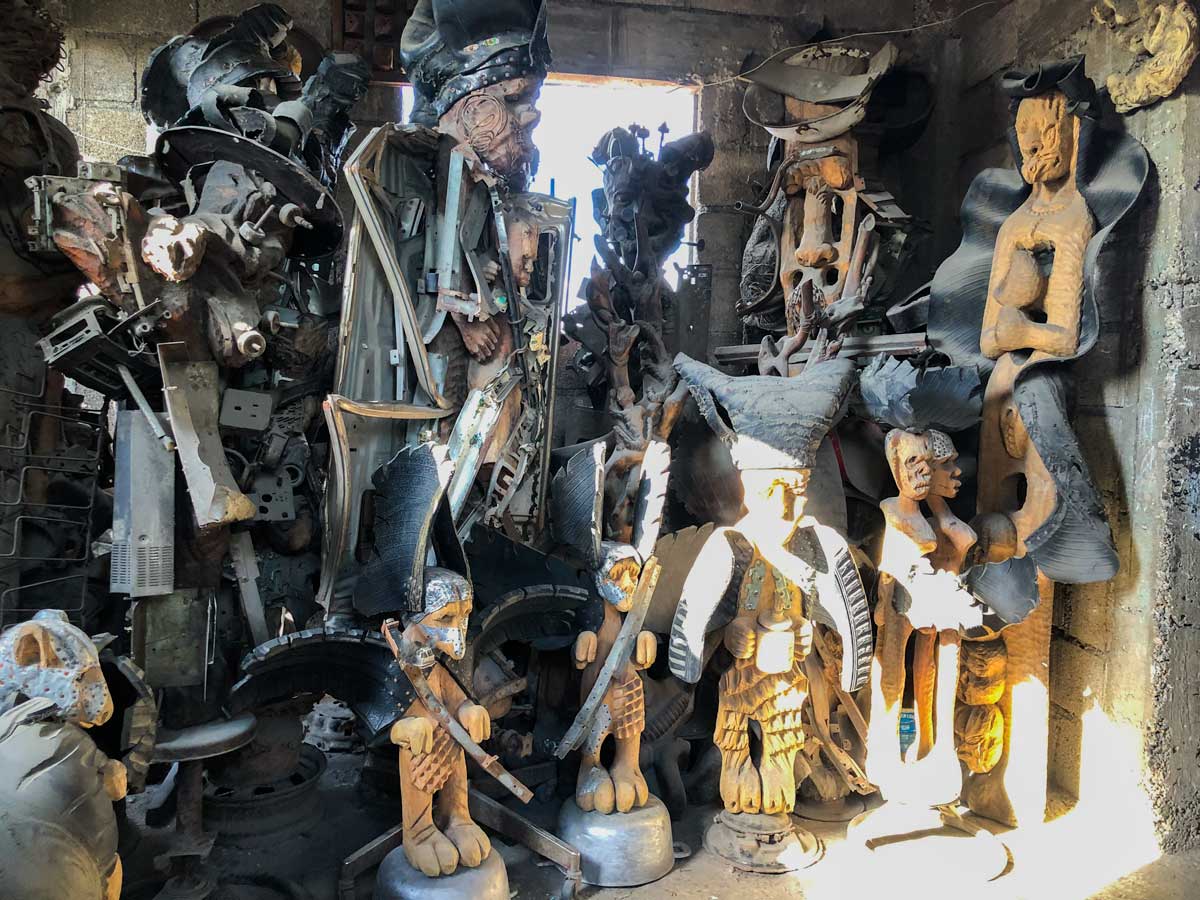
Photo: Anton Lau
The Spirit of Lakou
At the heart of Eugene’s counterculture movement lies the Haitian concept of Lakou, the spirit of communal sharing and bringing others along on your path to success. Folks around here call the studio “Lakou Eugene.”
Here in Lakou Eugene, rum and its un-distilled counterpart, clairin, flow as easily as the creative spirit. If you visit, no one will make you drink clairin, but there’s a good chance a cold beer – Prestige of course – will appear in your hand. I experienced this first-hand visiting during the Ghetto Biennale event of 2017.
Out of many, One
Eugene started out his career in construction as a house builder, but soon picked up the craft of woodcarving. He never imagined that he would invent a new artistic style or co-launch a global art movement. At first he was just learning traditional sculptural techniques from his neighbors. Eugene says “There was always something happening in our neighborhood with music, many sculptors and Vodou all around. This made me begin the life of an artist.”
But he didn’t stick to wood or traditional styles for long. Once he began exploring the broader creative landscape in Port-au-Prince, Eugene took his inspiration from contemporary Haitian artists like Mario Benjamin and Barbara Prezeau. As his style evolved to incorporate metal and other media, Eugene also noticed that fellow Haitian artists were either represented in bourgeoise-run galleries or were stuck selling their work in informal roadside stalls. Since these have to be disassembled every evening and re-hung on fence posts and street walls every day, they take time and passion away from creative work.
Eugene determined to open an alternative gallery space. “I wanted to have a gallery, not only a gallery, but it must be a museum. That is why I have given the name ‘E Pluribus Unum’ Musee d’art to my studio and lakou (yard)” said Eugene in an interview for the Atis Resistant’s official website.
What does it mean? “Museum E pluribus Unum” is written on a large flag at the lakou entrance. It reflects the ironic, humorous spirit that characterizes so much of his work because “E Pluribus Unum” means “Out of many, one” but it’s also the sigil used as the official seal of the United States of America. It appears on the currency, and seals all official documents like American passports. Placing the same motto over a sea of beheaded dolls, human skulls and cyberpunk Vodou, one could say Eugene reclaims the empire in the Atis Rezistans image.
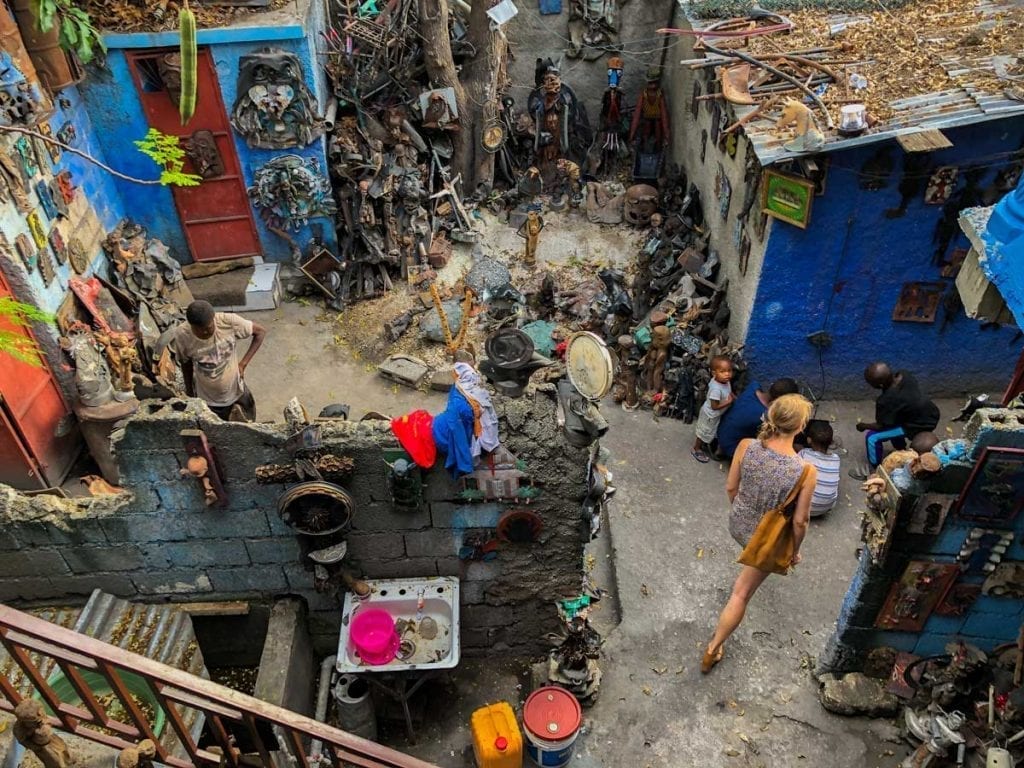
Photo: Anton Lau
Inspiration
Eugene’s raw material is everywhere in Grand Rue where mechanic shops and scrap yards abound. His sculptural style has been called post-apocalyptic, MTV futuristic, and Vodou cyberpunk. Due to the bold fusion of religious figures with sexuality, irony and symbolism it’s distinctly anti-bourgeois and anti-establishment.
Eugene’s work commonly features human skulls and doll faces perched atop twisted mixed-metal frames in the shape of a body. It could be the body of a bird, a snake god, or figurative works of the Christian effigy, all represented in expertly hammered metal, wood and purposeful randomness. Here you’ll see a broken sandal, there a tin cup, both atop an Amerindian chief’s shoulder. The chief’s face is carved in solid wood and crowned with a regal band of silver studs, rusted nails and strips of black rubber that rise in a six-foot crown. It’s impressive, it’s wildly imaginative, it’s taboo and it’s distinctly Atis Rezistans.
Ghetto Biennale
This grassroots Haitian art movement started getting international acclaim in the 2000’s, thanks largely to partnership with UK photographer, artist and curator Leah Gordon and the Ghetto Biennale art show. Biennale art shows take place in world capitals every two years, as a marquee artistic event with high levels of prestige accorded to participating artists, curators and galleries. Eugene and Leah decided to establish a ghetto edition, right in the heart of Port-au-Prince’s Grand Rue. What better headquarters for the alternative biennale show than Eugene’s studio “Museum E pluris Anum”?
The Ghetto Biennale brings 50-100 foreign artists to Haiti every two years to co-create with Haitian artists for three weeks, culminating in a neighborhood-wide exhibition. If you’re lucky enough to time your visit to Eugene’s studio with the Ghetto Biennale event, expect a riotous fusion of local and global creative energy. It’s a photographer’s delight and the charismatic Eugene soaks up the exposure.
Read more about the Ghetto Biennale here!
Recent Exhibitions
Eugene’s biography reads like the who’s who of international art exhibitions, both alternative and mainstream. With accolades from Paris’ beaux art museum, London’s Foundry, and Nottingham UK, his sculptures are featured in collections in near and far-flung creole sister islands like Barbados and Isle de la Reunion near Madagascar in East Africa.
He has conquered the so-called heart of the empire, with exhibitions of his sculptures happening in New York, Miami and Chicago since 2002. Eugene’s post-apocalyptic visions have toured Western Europe and Scandinavia.
What more could this carpenter from Grand Rue want? He’s currently out to inspire the next generation of the resistance.
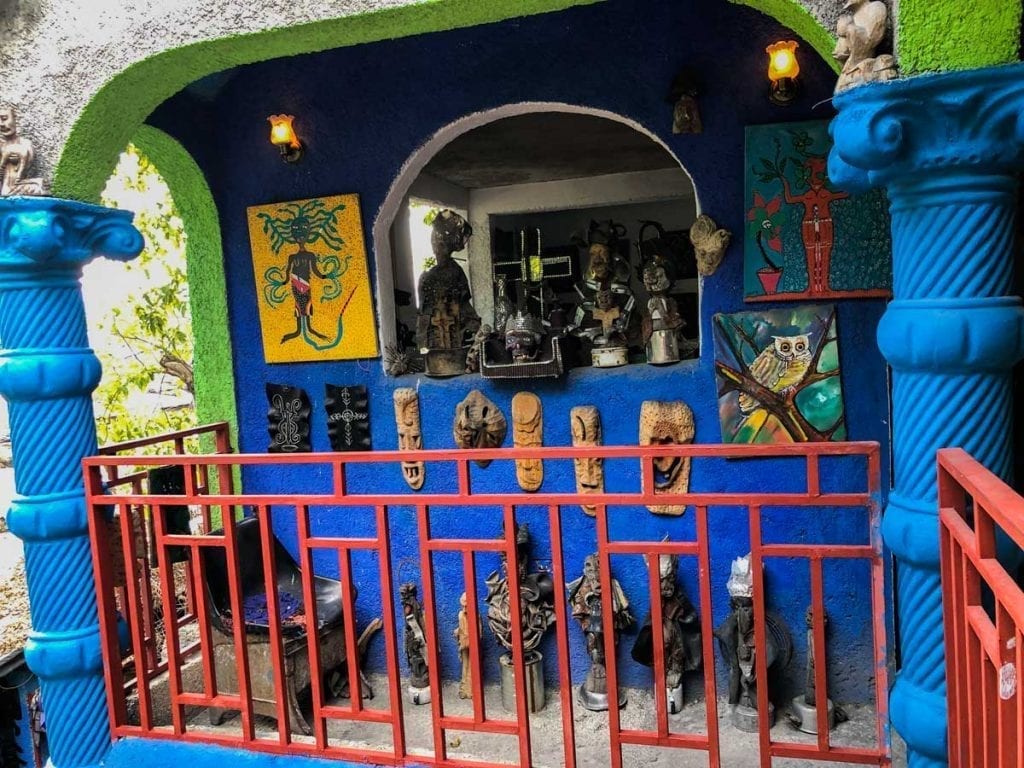
Photo: Anton Lau
Children of the resistance and the new resistance
Since 2012, a group of apprentice children ranging in age from six to eighteen years of age have been learning the craft of assemblage sculpture from the neighborhood veterans or ‘Gran Rezisans” like Andre Eugene and Jean Hérard Céleur.
The youth formed a collective and began exhibiting their creations under the title “Ti Moun Rezistance” which translates from creole to “Children of the Resistance”. Eugene’s rooftop studio often hosts workshops and exhibits their latest creations which are open to the public.
The most notable work created by Ti Moun Rezistans so far was a performance called “Tele Geto” featured in a recent Ghetto Biennale, and subsequently shown at London’s Portman Gallery. The children continue to include their work in local shows and take part in creative life of Grand Rue. Their work can be purchased locally in Grand Rue.
Splintering and rifts are an inevitable part of a authority-resistant creative movement like this, what with the cast of characters and rum-fueled friendships at the core of Atis Rezistans. Now, a collective of six next-generation artists has organized into the “New Resistance”, each talented in their own right. Several of the “new resistance” artists exhibit in the yards that lead into Eugene’s studio.
Regardless of the ebbs and flows of the community dynamic, Eugene remains one of the grand masters of this ironic and inventive style. His is a story of how one man’s imagination captivated the collective attention of a generation of sculptors and curators worldwide. Visiting Andre Eugene’s home studio is an immersive experience that only Haiti could craft, and for residents and visitors to Port-au-Prince, it’s a visit worth making.
Written by Emily Bauman.
Published October 2018
Find Atis Rezistans
External Links
Check out the official website of Atis Rezistans
Find out more about Atis Rezistans

Recommended

Paradise for your inbox
Your monthly ticket to Haiti awaits! Get first-hand travel tips, the latest news, and inspiring stories delivered straight to your inbox—no spam, just paradise.






